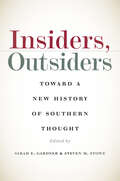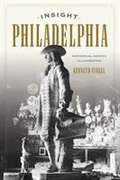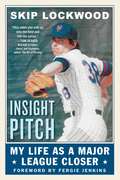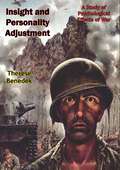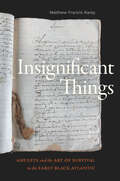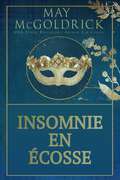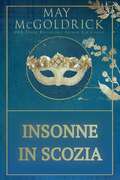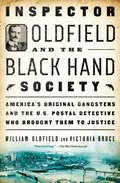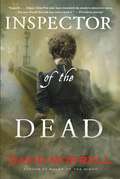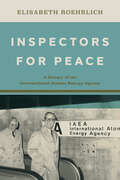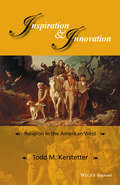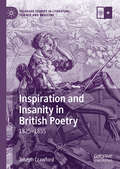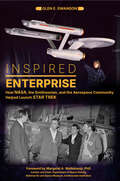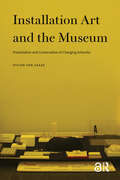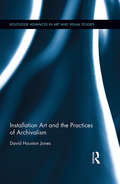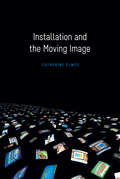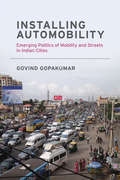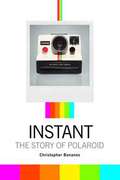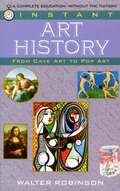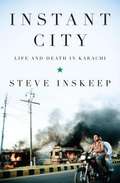- Table View
- List View
Insiders, Outsiders: Toward a New History of Southern Thought
by Sarah E. Gardner and Steven M. StoweThe history of thought and thinking in the American South is now alive with curiosity and poised for a new maturity. Thanks to the efforts of a growing variety of critics, the region is increasingly understood as a cultural habitat comprised of flows of ideas and sensibilities that originate both inside and outside traditional boundaries. This volume of essays uniquely combines perspectives from historians and literary scholars to explore a wide spectrum of thought about a region long understood as distinctive, yet often taken to represent "American" culture and character. Contributors first engage with how southern thinkers of all sorts have struggled with belonging--who is an insider and who is an outsider. Second, they consider how thought in the South has over time created ideas about the South. The volume capitalizes on an interdisciplinary synergy that has come to characterize southern studies, exploring current creative tensions between classic themes in southern history and the new ways to approach them. Region and identity, intellectuals and change, the South as an idea and ideas in the South—these continue to inspire the best new research as showcased in this collection. Contributors are Michael T. Bernath, Stephen Berry, John Grammer, Michael Kreyling, Scott Romine, Beth Barton Schweiger, Mitchell Snay, Melanie Benson Taylor, Jonathan Daniel Wells, and Timothy J. Williams.
Insight Philadelphia: Historical Essays Illustrated
by Kenneth FinkelEach of the nearly 100 essays in Insight Philadelphia tells a succinct, compelling, and little-known tale of the city’s past. Some stories are quirky, like how early gas stations were designed to resemble classical temples, or the saga of how a museum acquired a 2000-year-old Greek statue, then had it demolished with a sledgehammer. Other stories turn serious, exploring the tragic deaths of child laborers in the city’s textile mills and a century-old case of racial profiling that led to a stationhouse murder. Historian Kenneth Finkel introduces readers to the many brave souls and colorful characters who left their mark on the city, from the Irish immigrant “coal heavers”—who initiated the nation’s first general strike—to the teenage Josephine Baker making a flashy debut on the Philadelphia stage. Illustrated with scores of rare archival images, Insight Philadelphia will give readers a new appreciation for the people and places that make the City of Brotherly Love so unique.
Insight Pitch: My Life as a Major League Closer
by Skip Lockwood Fergie JenkinsYou're straddling the pitcher's mound in Shea Stadium. The game rests in your hands. Your heart is pounding. Big money is at stake. You feel thousands of eyes burning your jersey as they wait for a pitch. You gulp at the air trying to settle your nerves. It's go time. Insight Pitch is a sports story that spills over three decades. Retired Major League Baseball pitcher Skip Lockwood tells anecdotes from throughout his career as a ballplayer, starting with his days as a Little Leaguer through his professional tenure with the Kansas City Athletics, Seattle Pilots, Milwaukee Brewers, California Angels, New York Mets, and Boston Red Sox, before his retirement in 1980. Along the way, he details both the on- and off-the-field shenanigans as well as the enormous psychological process that he underwent each and every time he took the mound. Readers will find some laughs along the way and marvel as they share the locker room with legends like Jesse Owens, Satchel Paige, Catfish Hunter, and Yogi Berra. Humorous but insightful, this book makes the perfect addition to any baseball fan's shelf.
Insight and Personality Adjustment: A Study of Psychological Effects of War
by Therese BenedekSudden changes in the social scene, upheavals such as are wrought by economic depression, by revolutions and by wars, lay bare for our observation the interaction between the individual and society; they expose sharply the individual and his relationship to his primary social unit: the family. The war, with the shocklike interruption of the usual tempo of living, wrote a new, clearly defined chapter in the life of the individual as well as of the nation. And the family bears the brunt of the upheaval. Sociologists as well as psychiatrists look upon the family with concern. Will the family—this proven institution of many tasks—be able to carry on and continue to conserve our cultural inheritance, conveying it to a new, rebellious generation? Will it be able, at the same time, to keep step with the progress which our complex society impatiently forces upon its traditions?Impressed by the impact of the war upon the population, the psychiatrist had endless opportunities to study and interpret its effects upon human relationships. For the war exposed the images, illusions, expectations and disappointments which each of us harbors as indelible impressions of living together. Thus conflicts which already might have receded into inactivity during the routine of peacetime living were stirred into consciousness and demanded attention.
Insignificant Things: Amulets and the Art of Survival in the Early Black Atlantic (The Visual Arts of Africa and its Diasporas)
by Matthew Francis RareyIn Insignificant Things Matthew Francis Rarey traces the history of the African-associated amulets that enslaved and other marginalized people carried as tools of survival in the Black Atlantic world from the seventeenth to the nineteenth centuries. Often considered visually benign by white Europeans, these amulet pouches, commonly known as “mandingas,” were used across Africa, Brazil, and Portugal and contained myriad objects, from herbs and Islamic prayers to shells and coins. Drawing on Arabic-language narratives from the West African Sahel, the archives of the Portuguese Inquisition, sixteenth- and seventeenth-century European travel and merchant accounts of the West African Coast, and early nineteenth-century Brazilian police records, Rarey shows how mandingas functioned as portable archives of their makers’ experiences of enslavement, displacement, and diaspora. He presents them as examples of the visual culture of enslavement and critical to conceptualizing Black Atlantic art history. Ultimately, Rarey looks to the archives of transatlantic slavery, which were meant to erase Black life, for objects like the mandingas that were created to protect it.
Insistent Life: Principles for Bioethics in the Jain Tradition
by Brianne Donaldson Ana BajželjA free open access ebook is available upon publication. Learn more at www.luminosoa.org. Jainism, perhaps more so than any other South Asian tradition, focuses strongly on the ethics of birth, life, and death, with regard to both humans and other living beings. Insistent Life is the first full-length interdisciplinary examination of the foundational principles of bioethics within Jain doctrine and the application of those principles in the contemporary sphere. Brianne Donaldson and Ana Bajželj analyze a diverse range of Jain texts and contemporary sources to identify Jain perspectives on bioethical issues while highlighting the complexity of their personal, professional, and public dimensions. The book also features extensive original data based on an international survey the authors conducted with Jain medical professionals in India and diaspora communities of North America, Europe, and Africa.
Insisting on the Impossible: The Life of Edwin Land, Inventor of Instant Photography (Sloan Technology Series)
by Victor K. McelhenyThis fascinating biography of the great inventor and entrepreneur Edwin Land captures the very essence of technological innovation. Renowned as the inventor of instant photography, Land won 535 patents, joining Edison among the world's most prolific inventors. While still in his teens, this Magellan of modern technology invented sheet polarizers and went on to build a tiny research lab into a gigantic enterprise that turned out a vast and continuous array of innovations. McElheny draws a vivid and memorable portrait of this extraordinary man, in the lab, in the boardroom, in high-secret defense work including the spearheading of the U2 spy plane. His penetrating insight into Land's innovative genius will speak to anyone interested in business, science, photography or government.
Insomnie En Écosse (Série Famille Pennington)
by Jan Coffey May McGoldrickUn thriller romantique haletant où la passion affronte le danger, et où chaque secret peut coûter la vie. Série Famille Pennington UN HÉROS BLESSÉ... UNE FEMME AVEC DES SECRETS... UN TUEUR TAPI DANS LES BRUMES... LE SCANDALE, L'AMOUR ET LA MAIN DU DESTIN... Le capitaine Ian Bell est un homme torturé qui lutte contre le chagrin et la culpabilité depuis la perte de sa sœur. Trois ans plus tard, Ian continue de traquer son meurtrier dans le dangereux milieu criminel d'Édimbourg. Une nuit, une jeune femme échappe de peu à la mort et s'effondre à ses pieds... la meilleure amie de sa défunte sœur, Phoebe Pennington. Lady Phoebe Pennington, rêveuse et conteuse pour sa famille, est une réformatrice passionnée qui rédige des articles anonymes pour un journal d'Édimbourg. Une nuit, Phoebe descend dans le monde souterrain corrompu et effervescent connu sous le nom de Vaults. Lorsqu'elle tente de sauver un gamin des griffes d'un agresseur, elle devient la cible d'une violente attaque, avant d'être sauvée par l'homme qu'elle désire depuis des années. L'attirance d'Ian pour Phoebe est aussi indéniable qu'inattendue, et elle réveille en lui des passions qu'il croyait mortes depuis longtemps. Le sang de Phoebe s'enflamme pour Ian, mais lorsqu'elle apprend qu'il pourrait être impliqué dans le scandale qu'elle est déterminée à révéler, elle se retrouve déchirée entre l'amour et la vérité. Mais le destin les réunit, car Phoebe est la seule à avoir vu le visage du tueur, et les ombres maléfiques sont plus proches qu'ils ne l'imaginent.
Insonne in Scozia: Serie della famiglia Pennington (Serie della famiglia Pennington)
by Jan Coffey May McGoldrickSerie della famiglia Pennington UN EROE FERITO... UNA DONNA CON DEI SEGRETI... UN ASSASSINO IN AGGUATO NELLE NEBBIE... SCANDALO, AMORE E LA MANO DEL DESTINO... Il capitano Ian Bell è un uomo tormentato che lotta contro il dolore e il senso di colpa per la perdita della sorella. Ora, tre anni dopo, Ian dà ancora la caccia all'assassino nel pericoloso mondo criminale di Edimburgo. Poi, una notte, una giovane donna sfugge per poco alla morte e finisce ai suoi piedi... la migliore amica della sua defunta sorella, Phoebe Pennington. Lady Phoebe Pennington - sognatrice e narratrice per la sua famiglia - è una riformatrice impegnata che scrive articoli anonimi per un giornale di Edimburgo. Una notte, Phoebe scende nel corrotto e ribollente mondo sotterraneo noto come Vaults. Quando cerca di salvare un monello di strada da un aggressore, diventa il bersaglio di un violento attacco, per poi essere salvata dall'unico uomo che ha desiderato per anni. L'attrazione di Ian per Phoebe è tanto innegabile quanto inaspettata e lei risveglia in lui passioni che credeva morte da tempo. Il sangue di Phoebe brucia per Ian, ma quando scopre che lui potrebbe essere coinvolto nello scandalo che lei è decisa a denunciare, si trova combattuta tra l'amore e la verità. Ma il destino ci mette lo zampino, perché Phoebe è l'unica ad aver visto il volto dell'assassino e le ombre del male sono più vicine di quanto immaginino.
Inspector Oldfield and the Black Hand Society: America's Original Gangsters and the U.S. Postal Detective who Brought Them to Justice
by Victoria Bruce William OldfieldThe incredible true story of the US Post Office Inspector who took down the deadly Black Hand, a turn-of-the-century Italian-American secret society that preyed on immigrants across America’s industrial heartland—featuring fascinating and never-before-seen documents and photos from the Oldfield family’s private collection.Before the emergence of prohibition-era gangsters like Al Capone and Lucky Luciano, there was the Black Hand: an early twentieth-century Sicilian-American crime ring that preyed on immigrants from the old country. In those days, the FBI was in its infancy, and local law enforcement were clueless against the dangers—most refused to believe that organized crime existed. Terrorized victims rarely spoke out, and the criminals ruled with terror—until Inspector Frank Oldfield came along. In 1899, Oldfield became America’s 156th Post Office Inspector—joining the ranks of the most powerful federal law enforcement agents in the country. Based in Columbus, Ohio, the unconventional Oldfield brilliantly took down train robbers, murderers, and embezzlers from Ohio to New York to Maryland. Oldfield was finally able to penetrate the dreaded Black Hand when a tip-off put him onto the most epic investigation of his career, culminating in the 1909 capture of sixteen mafiosos in a case that spanned four states, two continents—and ended in the first international organized crime conviction in the country. Hidden away by the Oldfield family for one hundred years and covered-up by rival factions in the early 20th century Post Office Department, this incredible true story out of America’s turn-of-the-century heartland will captivate all lovers of history and true crime.
Inspector of the Dead (Thomas and Emily De Quincey #2)
by David MorrellLEGENDARY THRILLER WRITER DAVID MORRELL TRANSPORTS READERS TO THE FOGBOUND STREETS OF LONDON, WHERE A KILLER PLOTS TO ASSASSINATE QUEEN VICTORIA.The year is 1855. The Crimean War is raging. The incompetence of British commanders causes the fall of the English government. The Empire teeters. Amid this crisis comes opium-eater Thomas De Quincey, one of the most notorious and brilliant personalities of Victorian England. Along with his irrepressible daughter, Emily, and their Scotland Yard companions, Ryan and Becker, De Quincey finds himself confronted by an adversary who threatens the heart of the nation.This killer targets members of the upper echelons of British society, leaving with each corpse the name of someone who previously attempted to kill Queen Victoria. The evidence indicates that the ultimate victim will be Victoria herself.ed on actual attempts to assassinate Queen Victoria, Inspector of the Dead brilliantly merges historical fact with fiction, bringing a bloody chapter of Victorian England to vivid, pulse-pounding life.
Inspector of the Dead: Thomas and Emily De Quincey 2 (Victorian De Quincey mysteries #2)
by David MorrellThe year is 1855. The Crimean war is raging. The British government has fallen. The Empire itself hangs in the balance.And then the murders start...Someone is targeting members of London's elite - leaving with each corpse the names of men who failed to assassinate Queen Victoria. It's clear that Victoria will be the ultimate victim. As the notorious Opium-Eater Thomas De Quincey and his daughter Emily race to save her, they uncover the heart-breaking past of a man whose lust for revenge has destroyed his soul.Based on actual attempts to assassinate the queen, Inspector of the Dead brilliantly merges fact with fiction, bringing a bloody chapter of Victorian England to vivid, pulse-pounding life.
Inspectors for Peace: A History of the International Atomic Energy Agency (Johns Hopkins Nuclear History and Contemporary Affairs)
by Elisabeth RoehrlichThe first comprehensive, empirically grounded, and independent study of the history of the IAEA.The International Atomic Energy Agency, which sends inspectors around the world to prevent states from secretly developing nuclear bombs, has one of the most important jobs in international security. At the same time, the IAEA is a global hub for the exchange of nuclear science and technology for peaceful purposes. Yet spreading nuclear materials and know-how around the world bears the unwanted risk of helping what the agency aims to halt: the emergence of new nuclear weapon states. In Inspectors for Peace, Elisabeth Roehrlich unravels the IAEA's paradoxical mission of sharing nuclear knowledge and technology while seeking to deter nuclear weapon programs. Founded in 1957 in an act of unprecedented cooperation between the Cold War superpowers, the agency developed from a small technical bureaucracy in war-torn Vienna to a key organization in the global nuclear order. Roehrlich argues that the IAEA's dual mandate, though apparently contradictory, was pivotal in ensuring the organization's legitimacy, acceptance, and success. For its first decade of existence, the IAEA was primarily a scientific and technical organization; it was not until the Treaty on the Non-Proliferation of Nuclear Weapons entered into force in 1970 that the agency took on the far-reaching verification and inspection role for which it is now most widely known. While the Fukushima nuclear disaster and the Iran negotiations made the IAEA's name famous, the organization's remarkable history remains strikingly absent from public knowledge. Drawing on extensive archival research, including firsthand access to newly opened records at the IAEA Archives in Vienna, Inspectors for Peace provides the first comprehensive, empirically grounded, and independent study on the history of the IAEA. Roehrlich also interviewed leading policymakers and officials, including Hans Blix and Nobel Peace laureate Mohamed ElBaradei, the agency's former heads. This book offers insight not only for students, scholars, and policy experts but for anyone interested in the history of the nuclear age, the Cold War, and the role of international organizations in shaping our world.
Inspiration and Innovation: Religion in the American West (Western History Series)
by Todd M. KerstetterCovering more than 200 years of history from pre-contact to the present, this textbook places religion at the center of the history of the American West, examining the relationship between religion and the region and their influence on one another. A comprehensive examination of the relationship between religion and the American West and their influence on each other over the course of more than 200 years Discusses diverse groups of people, places, and events that played an important historical role, from organized religion and easily recognized denominations to unorganized religion and cults Provides straightforward explanations of key religious and theological terms and concepts Weaves discussion of American Indian religion throughout the text and presents it in dialogue with other groups Enriches our understanding of American history by examining key factors outside of traditional political, economic, social, and cultural domains
Inspiration and Insanity in British Poetry: 1825–1855 (Palgrave Studies in Literature, Science and Medicine)
by Joseph CrawfordThis book explores the ways in which poetic inspiration came to be associated with madness in early nineteenth-century Britain. By examining the works of poets such as Barrett, Browning, Clare, Tennyson, Townshend, and the Spasmodics in relation to the burgeoning asylum system and shifting medical discourses of the period, it investigates the ways in which Britain’s post-Romantic poets understood their own poetic vocations within a cultural context that insistently linked poetic talent with illness and insanity. Joseph Crawford examines the popularity of mesmerism among the writers of the era, as an alternative system of medicine that provided a more sympathetic account of the nature of poetic genius, and investigates the persistent tension, found throughout the literary and medical writings of the period, between the Romantic ideal of the poet as a transcendent visionary genius and the ‘medico-psychological’ conception of poets as mere case studies in abnormal neurological development.
Inspired Enterprise: How NASA, the Smithsonian, and the Aerospace Community Helped Launch Star Trek
by Glen E. SwansonStar Trek is a phenomenon, spinoffs and reruns have been a near constant presence on international television for more than 50 years. More than a dozen feature films have been produced, with many more on the way.
Inspiring Fellini
by Federico PacchioniFederico Fellini is considered one of the greatest cinematic geniuses of our time, but his films were not produced in isolation. Instead, they are the results of collaborations with some of the greatest scriptwriters of twentieth-century Italy. Inspiring Fellini re-examines the filmmaker's oeuvre, taking into consideration the considerable influence of his collaborations with writers and intellectuals including Pier Paolo Pasolini, Ennio Flaiano, Tullio Pinelli, and Andrea Zanzotto. Author Federico Pacchioni provides a portrait of Fellini that is more complex than one of the stereotypical solitary genius, as he has been portrayed by Fellini criticism in the past. Pacchioni explores the dynamics of Fellini's cinematic collaborations through analyses of the writers' independently produced works, their contributions to the conceptualization of the films, and their conversations with Fellini himself, found in public and private archival sources. This book is an invaluable resource in the effort to understand the genesis of Fellini's artistic development.
Installation Art and the Museum: Presentation and Conservation of Changing Artworks
by Vivian SaazeInstallation art has become mainstream in artistic practices. However, acquiring and displaying such artworks implies that curators and conservators are challenged to deal with obsolete technologies, ephemeral materials and other issues concerning care and management of these artworks. By analysing three in-depth case studies, the author sheds new light on the key concepts of traditional conservation (authenticity, artist’s intention, and the notion of ownership) while exploring how these concepts apply in contemporary art conservation.,Based on original empirical research and cross-case analysis, this ground-breaking study offers a re-examination of traditional conservation values and ethics, and argues for a reassessment of the role of the conservator of contemporary art.
Installation Art and the Practices of Archivalism (Routledge Advances in Art and Visual Studies)
by David Houston JonesOn the leading edge of trauma and archival studies, this timely book engages with the recent growth in visual projects that respond to the archive, focusing in particular on installation art. It traces a line of argument from practitioners who explicitly depict the archive (Samuel Beckett, Christian Boltanski, Art & Language, Walid Raad) to those whose materials and practices are archival (Mirosław Bałka, Jean-Luc Godard, Silvia Kolbowski, Boltanski, Atom Egoyan). Jones considers in particular the widespread nostalgia for ‘archival’ media such as analogue photographs and film. He analyses the innovative strategies by which such artefacts are incorporated, examining five distinct types of archival practice: the intermedial, testimonial, personal, relational and monumentalist.
Installation and the Moving Image
by Catherine ElwesFilm and video create an illusory world, a reality elsewhere, and a material presence that both dramatizes and demystifies the magic trick of moving pictures. Beginning in the 1960s, artists have explored filmic and televisual phenomena in the controlled environments of galleries and museums, drawing on multiple antecedents in cinema, television, and the visual arts. This volume traces the lineage of moving-image installation through architecture, painting, sculpture, performance, expanded cinema, film history, and countercultural film and video from the 1960s, 1970s, and 1980s.Sound is given due attention, along with the shift from analogue to digital, issues of spectatorship, and the insights of cognitive science. Woven into this genealogy is a discussion of the procedural, political, theoretical, and ideological positions espoused by artists from the mid-twentieth century to the present. Historical constructs such as Peter Gidal's structural materialism, Maya Deren's notion of vertical and horizontal time, and identity politics are reconsidered in a contemporary context and intersect with more recent thinking on representation, subjectivity, and installation art.The book is written by a critic, curator, and practitioner who was a pioneer of British video and feminist art politics in the late 1970s. Elwes writes engagingly of her encounters with works by Anthony McCall, Gillian Wearing, David Hall, and Janet Cardiff, and her narrative is informed by exchanges with other practitioners. While the book addresses the key formal, theoretical, and historical parameters of moving-image installation, it ends with a question: "What's in it for the artist?"
Installing Automobility: Emerging Politics of Mobility and Streets in Indian Cities (Urban and Industrial Environments)
by Govind GopakumarAn examination of the process of prioritizing private motorized transportation in Bengaluru, a rapidly growing megacity of the Global South.Automobiles and their associated infrastructures, deeply embedded in Western cities, have become a rapidly growing presence in the mega-cities of the Global South. Streets once crowded with pedestrians, pushcarts, vendors, and bicyclists are now choked with motor vehicles, many of them private automobiles. In this book, Govind Gopakumar examines this shift, analyzing the phenomenon of automobility in Bengaluru (formerly known as Bangalore), a rapidly growing city of about ten million people in southern India. He finds that the advent of automobility in Bengaluru has privileged the mobility needs of the elite while marginalizing those of the rest of the population. Gopakumar connects Bengaluru's burgeoning automobility to the city's history and to the spatial, technological, and social interventions of a variety of urban actors. Automobility becomes a juggernaut, threatening to reorder the city to enhance automotive travel. He discusses the evolution of congestion and urban change in Bengaluru; the “regimes of congestion” that emerge to address the issue; an “infrastructurescape” that shapes the mobile behavior of all residents but is largely governed by the privileged; and the enfranchisement of an “automotive citizenship” (and the disenfranchisement of non-automobile-using publics). Gopakumar also finds that automobility in Bengaluru faces ongoing challenges from such diverse sources as waste flows, popular religiosity, and political leadership. These challenges, however, introduce messiness without upsetting automobility. He therefore calls for efforts to displace automobility that are grounded in reordering the mobility regime, relandscaping the city and its infrastructures, and reclaiming streets for other uses.
Instant
by Christopher Bonanos"Pictures in a minute!" In the 1950s, '60s, and '70s, Polaroid was the hottest technology company on Earth. They were an innovation machine that cranked out one irresistible product after another. It was even the company after which Steve Jobs is said to have modeled Apple, and the comparison is true. Jobs's hero, Edwin Land, Polaroid's visionary founder, turned his 1937 garage startup into a billion-dollar pop-culture phenomenon. Instant: The Story of Polaroid, a richly illustrated, behind-the-scenes look at the company, tells the tale of Land's extraordinary and beloved invention. From the introduction of Polaroid's first instant camera in 1948 to its meteoric rise and dramatic collapse into bankruptcy in the 2000s, Instant is both a cautionary tale about tech companies that lose their edge and a remarkable story of American ingenuity. Written in a breezy, accessible tone by New York magazine senior editor Chris Bonanos, this first book-length history of Polaroid also features colorful illustrations from Polaroid's history, including the company's iconic branding and marketing efforts.
Instant Art History: From Cave Art To Pop Art
by Walter RobinsonFrom the prehistoric cave paintings to Andy Warhol's soup cans, this lively chronicle surveys the rich history of artistic expression. INSTANT ART HISTORY examines such geniuses as Michelangelo, da Vinci, Rembrandt, Renoir, van Gogh, and the Impressionists as well as Dali, Matisse, Picasso, Kandinsky, and Lichtenstein. With INSTANT ART HISTORY you'll learn: * How Mona Lisa's smile changed forever the grim face of portrait sitters. * The differences between Analytic and Synthetic Cubism. * How the avant-garde movements of Constructivism, Dadaism, and Surrealism of the 1920s redefined how society viewed art. * How the action paintings of the Abstract Expressionists allow the viewer to "feel" a painting, not just see it.
Instant City
by Steve InskeepMorning Edition cohost Steve Inskeep presents a riveting account of a single harrowing day in December 2009 that sheds light on the constant tensions in Karachi, Pakistan—when a bomb blast ripped through a Shia religious procession, followed by the torching of hundreds of businesses in Karachi’s commercial district. Through interviews with a broad cross section of Karachi residents, Inskeep peels back the layers of that terrible day. It is the beginning, and a constant touchstone, in a journey across the city’s epic history and its troubled present Thrilling and deeply researched, Instant City tells the story of one of the world’s fastest-growing metropolises and the forces competing to shape its future. .
Instant Engineering: Key Thinkers, Theories, Discoveries and Inventions Explained on a Single Page (Instant Knowledge)
by Joel LevyKey thinkers, theories, discoveries, and inventions explained on a single page! Instant Engineering pulls together all the pivotal engineering theories and discoveries into one concise volume. Each page contains a distinct “cheat sheet,” which tells you the most important facts in bite-size chunks, so you can feel like an expert in minutes! From Archimedes to Elon Musk, from pumps and pulleys to the steam engine, and from the canal boat to the space rocket—every key figure, theory, or term is expressed in succinct and lively text and graphics. Perfect for the knowledge-hungry and time-poor, this collection of graphics-led lessons makes engineering interesting and accessible. Everything you need to know—and more!—packed into one convenient volume.
